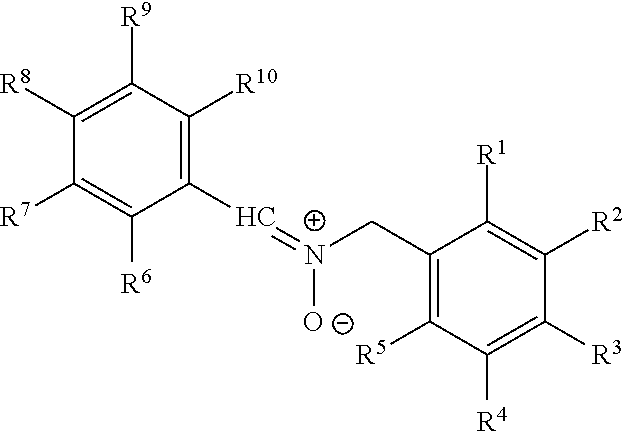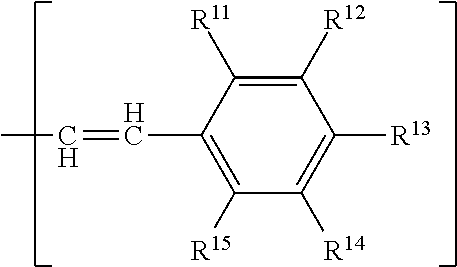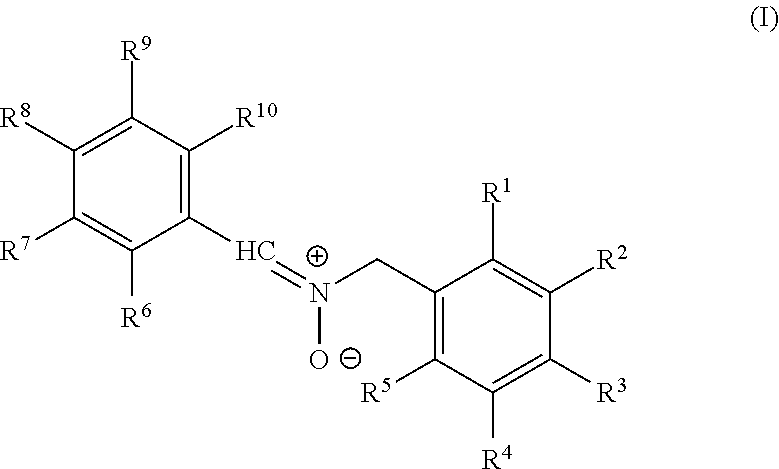Nitrone compounds and their use in personal care
a technology of nitrones and compounds, which is applied in the field of nitrones and their use in personal care, can solve the problems that the performance of nitrones cannot be achieved, and achieve the effects of less oxidative damage, less oxidative damage, and longer antioxidant protection
- Summary
- Abstract
- Description
- Claims
- Application Information
AI Technical Summary
Benefits of technology
Problems solved by technology
Method used
Image
Examples
example 1
Synthesis of the Oxime Precursor 3,4-Dihydroxybenzaldehyde Oxime (34DHBzOx)
[0037]
[0038]A 100 mL 3-neck flask was equipped with a magnetic stirrer, a reflux condenser, an addition funnel, a thermocouple, an ice bath, and a nitrogen blanket. The flask was charged with 13.81 grams (0.10 mole) of 3,4-dihydroxybenzaldehyde and with 50 mL of 100% ethanol. The mixture was stirred at room temperature under nitrogen to give a clear dark brown solution. The solution was cooled to <15° C. The addition funnel was charged with 6.63 grams (0.10 mole) of 50 wt. % aqueous hydroxylamine solution. The hydroxylamine solution was added to the cooled aldehyde solution over a period of about 45 minutes. During the addition, the reaction mixture temperature was maintained at <20° C. After completing the hydroxylamine solution addition, the reaction mixture was heated at 55° C. until GC analysis showed that the aldehyde was essentially gone (about 7 hours). The reaction mixture was solvent-stripped by rota...
example 2
Synthesis of the Hydroxylamine Precursor 4-((Hydroxyamino)methyl)benzene-1,2-diol (34DHBzHA)
[0042]
[0043]A 125 mL 3-neck flask was equipped with a magnetic stirrer, a sintered glass sparging tube, a pH electrode with meter, and a Claisen adapter fitted with a thermocouple and a gas outlet. The flask was charged with 4.59 grams (0.03 mole) of the 3,4-dihydroxybenzaldehyde oxime (34DHBzOx) prepared in Example 1 above and with 40 mL of methanol. The mixture was stirred at room temperature to give a clear brown solution. Sodium cyanoborohydride (1.89 grams, 0.03 mole) was then added to the oxime solution in one portion. A lecture bottle of hydrogen chloride gas was connected to the sparging tube with a safety trap in between. The HCl bottle was opened just enough to allow a trickle of gas to sparge into the reaction mixture. The pH of the mixture dropped quickly from about 7 to <3. At the same time, the reaction mixture foamed vigorously and solids began to precipitate. Sparging with HCl...
example 3
Synthesis of Stilbene Aldehyde Precursor (E)-2-hydroxy-5-(4-hydroxy-3-methoxystyryl) benzaldehyde (Sald)
[0044]
[0045]A flask was charged with 25 g (0.166 moles) of 2-methoxy-4-vinylphenol in 300 mL of anhydrous DMF. The following compounds were added to the resulting solution in order under stirring and nitrogen purge: 34.94 g (0.166 mole) of 3,5-bromosalicyaldehyde, 0.745 g (0.0033 mole) of palladium acetate, 0.201 g (0.0006 mole) of tri-o-tolylphosphine, and 34.64 mL (0.249 moles, 1.5 equivalent) of triethylamine. The mixture was heated for 30 hours at 110° C. and filtered through a Celite 545 packed funnel at room temperature. The composition was extracted with 50 mL of chloroform, followed by washing with 100 mL of water three times. The organic layer was dried over MgSO4. After removing the solvent under vacuum, the stilbene aldehyde compound was isolated by column chromatography on silica gel (chloroform). The resulting oil was crystallized by 5 mL of ethyl acetate and 100 mL o...
PUM
| Property | Measurement | Unit |
|---|---|---|
| wt. % | aaaaa | aaaaa |
| temperature | aaaaa | aaaaa |
| temperature | aaaaa | aaaaa |
Abstract
Description
Claims
Application Information
 Login to View More
Login to View More - R&D
- Intellectual Property
- Life Sciences
- Materials
- Tech Scout
- Unparalleled Data Quality
- Higher Quality Content
- 60% Fewer Hallucinations
Browse by: Latest US Patents, China's latest patents, Technical Efficacy Thesaurus, Application Domain, Technology Topic, Popular Technical Reports.
© 2025 PatSnap. All rights reserved.Legal|Privacy policy|Modern Slavery Act Transparency Statement|Sitemap|About US| Contact US: help@patsnap.com



